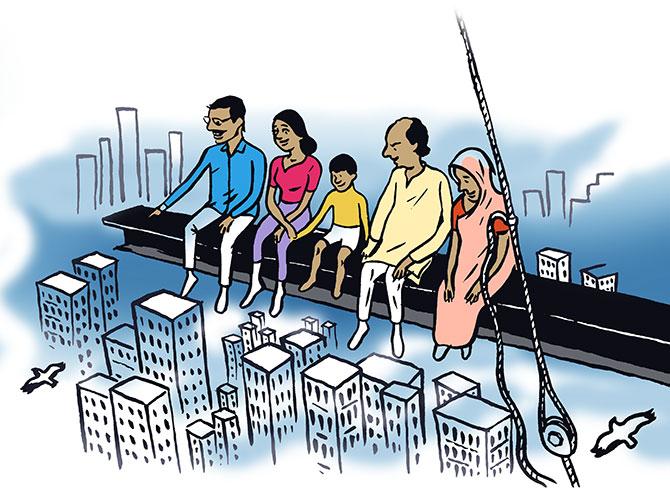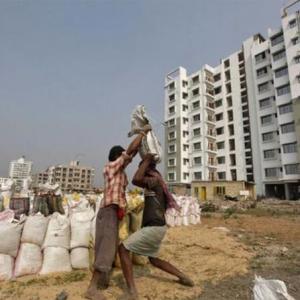'The government has to stop trying to fix things for lenders, projects, homeowners and developers and think instead about how to fix the market for houses,' says Mihir S Sharma.
Illustration: Dominic Xavier/Rediff.com

It is something of a relief that the Union government finally appears to have accepted that the Indian economy is slowing sharply, across sectors and geographies, thanks to a combination of cyclical and structural factors.
This means that the government’s famed decisiveness is finally being applied to the Indian economy.
The problem is, however, that the diagnoses are wrong, and perhaps even the understanding of the problems is a little deficient, thanks to the shortage of economics expertise at the highest level.
Thus, too many of the decisions move in the wrong direction.
Rather than making the minimum intervention required to ensure that markets begin to work properly, they seek to prop up all stakeholders in the hope that recovery is just around the horizon.
Consider as an example the decision by the Union Cabinet on November 7 to set up an alternative investment fund (AIF) worth Rs 25,000 crore to address the stalled projects problem in the real estate sector.
Here the issue appears clear.
There are over 1,500 stalled projects in the sector, affecting nearly half a million housing units.
More than two-thirds of these are in Greater Mumbai and the National Capital Region.
The developers behind these projects have mostly taken out loans to finance their development; they cannot complete the projects without more financing, but banks that are already seeing their bad loans to the sector multiply are reluctant to throw good money after bad.
The AIF, in this context, is simply an infusion of capital into the sector that will provide the gap financing necessary to unblock the pipeline, complete some projects, get those housing units into the market, and allow the market to resume normal operation.
There are some positive aspects to the design.
First of all, there is unquestionably an appetite in private capital for stressed assets as long as there is explicit government partnership.
Second, the AIF will take an interest in the relatively high-cost units that are actually blocking the pipeline -- up to Rs 2 crore unit price in Mumbai, and Rs 1.5 crore in Delhi.
The notion here is that this is a cyclical issue which can be addressed by appropriate counter-cyclical policy.
Revive the projects, the developers, and the banks, and recovery will follow.
Comparisons are being drawn to the real-estate bailout by the United States following the financial crisis.
But the questions that are being asked of the proposal need to be addressed.
Perhaps the most basic is this: Will even Rs 25,000 crore be enough?
As Business Standard has pointed out editorially, by some estimates this will be able to impact only 16% of stalled projects.
Efforts of this sort, such as the US's TARP (Troubled Asset Relief Program), need to be overwhelming in size in order to restore confidence in the market.
A cash-strapped government might not be able to commit the resources that are actually needed.
The hope perhaps is that with budgetary support of Rs 10,000 crore, further inputs from the Life Insurance Corporation and nationalised banks, private capital might be enthused to match government funds.
But then the next question that will have to be asked is whether private capital -- or even for that matter the banks -- will consider this programme a safe enough deployment of their funds.
The AIF has been structured to include, for example, projects that may have to go through the National Company Law Tribunal.
But such cases have been demonstrated recently to be vulnerable to legal challenges of one sort or another.
There is a degree of reluctance in finance to become exposed to a process in which all the legal kinks have not yet been worked out.
More broadly, the question that should be asked is whether the correct diagnosis has been made of the problem.
The government has said that the investment managers can take a call to replace the project developers if necessary.
But this should, in fact, be necessary much of the time.
Yet if the promoters are replaced, who will market and sell the completed units?
The AIF? The lenders? Or should the government instead also focus on building a platform that allows such completed units to be auctioned so that proper price discovery takes place?
The real problem here is that few of these projects will approach anything close to the value that has been set on them in the past, not just by developers but also by lenders.
This is a natural consequence of the weakened demand in the economy, and the consistent refusal to lower prices over the past decade.
Demand in metro areas is growing at only 4% to 5%, while supply is growing in double digits and perhaps close to 20% .
Meanwhile, there are over a million unsold units.
When you have this sort of mismatch, there is only one possible response: To drop prices till supply and demand are once again in balance.
But if you drop prices, then both promoters and lenders will have to take a haircut which nobody is willing to do.
It is this basic problem that the government will have to address.
It cannot ginger up demand.
But it can certainly incentivise the lenders that it controls to come clean about the extent of the hole they would be in if the market were functioning cleanly, and prices were to drop.
In other words, we have to stop trying to fix things for lenders, projects, homeowners and developers and think instead about how to fix the market for houses.
Only then will the sector emerge from its current crisis.
Throughout the economy, a clean-up process that would require the loss of equity by promoters and haircuts for lenders has been postponed, and so investment and growth has not returned to natural levels.
The real estate sector is just one instance of this problem, if more consequential than most.
The government will have to accept that it needs to ensure a structural clean-up rather than viewing this as a cyclical problem that can be solved with a small amount of money.
The real estate sector is crucial to the broader economy not just because of its backward linkages -- to cement and steel sectors, for example -- but also because it is a big employer of unskilled labour and an investment asset for the middle class.
The problem has traditionally been that the latter function takes on great political salience, with government policy towards the sector biased towards maintaining prices rather than deepening the market.
This bias must end.
The Indian middle class will have to learn, just as other middle classes in other economies have, that house prices can fall.
Houses are not an investment asset for individuals and households.
They are something you buy to live in.










